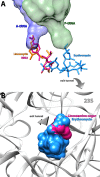Structural insights of lincosamides targeting the ribosome of Staphylococcus aureus
- PMID: 28973455
- PMCID: PMC5622323
- DOI: 10.1093/nar/gkx658
Structural insights of lincosamides targeting the ribosome of Staphylococcus aureus
Abstract
Antimicrobial resistance within a wide range of pathogenic bacteria is an increasingly serious threat to global public health. Among these pathogenic bacteria are the highly resistant, versatile and possibly aggressive bacteria, Staphylococcus aureus. Lincosamide antibiotics were proved to be effective against this pathogen. This small, albeit important group of antibiotics is mostly active against Gram-positive bacteria, but also used against selected Gram-negative anaerobes and protozoa. S. aureus resistance to lincosamides can be acquired by modifications and/or mutations in the rRNA and rProteins. Here, we present the crystal structures of the large ribosomal subunit of S. aureus in complex with the lincosamides lincomycin and RB02, a novel semisynthetic derivative and discuss the biochemical aspects of the in vitro potency of various lincosamides. These results allow better understanding of the drugs selectivity as well as the importance of the various chemical moieties of the drug for binding and inhibition.
© The Author(s) 2017. Published by Oxford University Press on behalf of Nucleic Acids Research.
Figures





Similar articles
-
Lincosamides: Chemical structure, biosynthesis, mechanism of action, resistance, and applications.Biochem Pharmacol. 2017 Jun 1;133:20-28. doi: 10.1016/j.bcp.2016.12.001. Epub 2016 Dec 7. Biochem Pharmacol. 2017. PMID: 27940264 Review.
-
Lincosamide Antibiotics: Structure, Activity, and Biosynthesis.Chembiochem. 2024 Mar 15;25(6):e202300840. doi: 10.1002/cbic.202300840. Epub 2024 Jan 15. Chembiochem. 2024. PMID: 38165257 Review.
-
Lincomycin and clindamycin conformations. A fragment shared by macrolides, ketolides and lincosamides determined from TRNOE ribosome-bound conformations.Bioorg Med Chem. 2000 Jun;8(6):1225-43. doi: 10.1016/s0968-0896(00)00081-x. Bioorg Med Chem. 2000. PMID: 10896103
-
Microbial kinetics of drug action against gram-positive and gram-negative organisms. III: Effect of lincomycin and clindamycin combinations on Staphylococcus aureus and Escherichia coli.J Pharm Sci. 1975 Oct;64(10):1621-6. doi: 10.1002/jps.2600641006. J Pharm Sci. 1975. PMID: 1102659
-
Lincosamides: chemical structure, biosynthesis, mechanism of action, resistance, and applications.Adv Appl Microbiol. 2004;56:121-54. doi: 10.1016/S0065-2164(04)56004-5. Adv Appl Microbiol. 2004. PMID: 15566978 Review. No abstract available.
Cited by
-
One-pot chemoenzymatic syntheses of non-canonical amino acids.J Ind Microbiol Biotechnol. 2024 Jan 9;51:kuae005. doi: 10.1093/jimb/kuae005. J Ind Microbiol Biotechnol. 2024. PMID: 38271597 Free PMC article. Review.
-
Discovery of small-molecule inhibitors targeting the ribosomal peptidyl transferase center (PTC) of M. tuberculosis.Chem Sci. 2019 Aug 6;10(38):8764-8767. doi: 10.1039/c9sc02520k. eCollection 2019 Oct 14. Chem Sci. 2019. PMID: 31803448 Free PMC article.
-
Ribosome-binding and anti-microbial studies of the mycinamicins, 16-membered macrolide antibiotics from Micromonospora griseorubida.Nucleic Acids Res. 2021 Sep 20;49(16):9560-9573. doi: 10.1093/nar/gkab684. Nucleic Acids Res. 2021. PMID: 34417608 Free PMC article.
-
Recent development and fighting strategies for lincosamide antibiotic resistance.Clin Microbiol Rev. 2024 Jun 13;37(2):e0016123. doi: 10.1128/cmr.00161-23. Epub 2024 Apr 18. Clin Microbiol Rev. 2024. PMID: 38634634 Free PMC article. Review.
-
Machine learning approaches to optimize small-molecule inhibitors for RNA targeting.J Cheminform. 2022 Feb 2;14(1):4. doi: 10.1186/s13321-022-00583-x. J Cheminform. 2022. PMID: 35109921 Free PMC article.
References
-
- World Health Organization Antimicrobial Resistance: Global Report on Surveillance. 2014; Geneva: World Health Organization.
-
- Lowy F.D. Staphylococcus aureus infections. N. Engl. J. Med. 1998; 339:520–532. - PubMed
-
- Marcinak J.F., Frank A.L.. Treatment of community-acquired methicillin-resistant Staphylococcus aureus in children. Curr. Opin. Infect. Dis. 2003; 16:265–269. - PubMed
-
- Johnson M.D., Decker C.F.. Antimicrobial agents in treatment of MRSA infections. Dis. Mon. 2008; 54:793–800. - PubMed
Publication types
MeSH terms
Substances
LinkOut - more resources
Full Text Sources
Other Literature Sources

